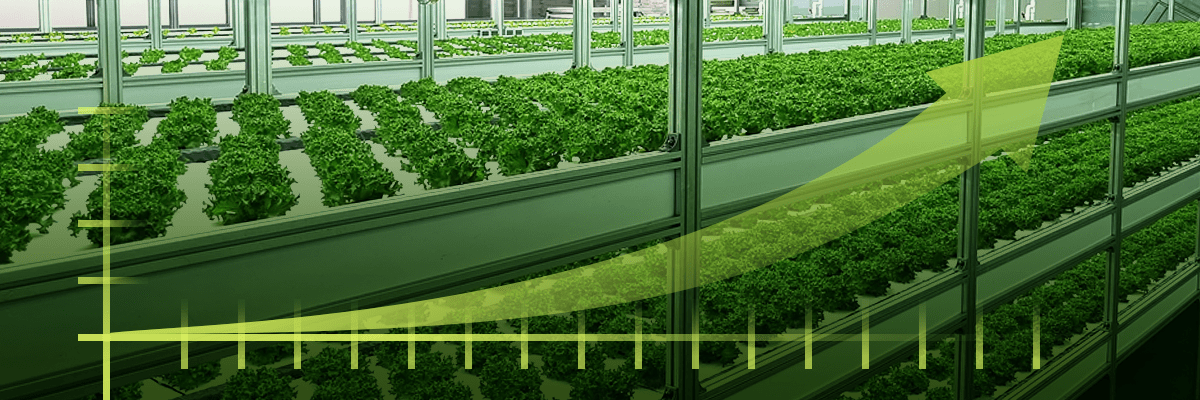The Global Spotlight on Vertical Farming:
Market Size and Growth Potential
The environmentally friendly cultivation methods and high land-use efficiency of vertical farms have led numerous primary industry corporations worldwide to actively research and develop fully integrated agricultural technology solutions. In line with this global trend, this article conducts a country-specific analysis of the worldwide smart farm industry, followed by an assessment of South Korea’s domestic market size, ultimately exploring the future trajectory of vertical farming technology.

According to a 2019 report by South Korea’s Rural Development Administration (Research and Analysis for Developing Urban Smart Agriculture Models), the global vertical farming market size was estimated at $2.23 billion in 2018, with projections indicating an exponential rise to $19.84 billion by 2028. Among the leading nations in vertical farming, the United States, China, the Netherlands, and Japan stand out as key players.
The United States is particularly dominant in most agricultural innovation, accounting for 38.84% of the global vertical farming lighting industry, while its hydroponic nutrient solution sector holds an impressive 55.56% of the global market share. Naturally, the overall vertical farm industry in the U.S. is substantial, with a 2023 market valuation of $735.6 million, according to Grand View Research. This figure is projected to experience steady annual growth of 19.1% through 2030.
Other nations also exhibit strong vertical farming market expansion. Reports from GlobeNewswire, Actual Market Research, and Statista indicate that the Dutch vertical farm market, valued at $4.2 billion in 2023, is expected to soar to $31.2 billion by 2030, positioning the Netherlands as the world’s second-largest vertical farm exporter. China’s vertical farming industry, valued at $360 million in 2021, is predicted to nearly double by 2028, while both Japan and the United Kingdom are projected to reach market sizes of $2.3 billion and $200 million, respectively, by 2028–2029.
In South Korea, the vertical farming market was valued at $180 million (KRW 250 billion) in 2018, with projections estimating an increase to $650 million (KRW 923 billion) by 2028, based on the same government report. These figures reflect the fast-growing digitalization of agriculture, the inherent value of vertical farming, and the healthy competition among agTech enterprises driving continuous advancements in the domestic market. Despite high initial installation and maintenance costs, South Korea’s vertical farm industry presents substantial research potential. Companies such as Nongshim Farm, which focus on high-value crop cultivation, have successfully developed technologies and expanded exports, demonstrating the viability of smart agriculture within the domestic and global market.
A unique characteristic of South Korean vertical farming technology is the high level of interest from Middle Eastern nations such as the United Arab Emirates, Saudi Arabia, and Kuwait. South Korean vertical farm enterprises maintain strong partnerships with these countries, highlighting the global relevance of South Korean smart farm systems.
Given the growing international demand, Korean vertical farm companies must focus on technological advancements that enhance economic viability, reducing cost disparities with leading global competitors. Nongshim Farm, for instance, has significantly expanded automation within its vertical farming facilities, boosting crop yield to multiples of initial investment costs. This rapid development suggests that South Korea is positioned to play a crucial role in shaping the global smart farm industry.
The United States is particularly dominant in most agricultural innovation, accounting for 38.84% of the global vertical farming lighting industry, while its hydroponic nutrient solution sector holds an impressive 55.56% of the global market share. Naturally, the overall vertical farm industry in the U.S. is substantial, with a 2023 market valuation of $735.6 million, according to Grand View Research. This figure is projected to experience steady annual growth of 19.1% through 2030.
Other nations also exhibit strong vertical farming market expansion. Reports from GlobeNewswire, Actual Market Research, and Statista indicate that the Dutch vertical farm market, valued at $4.2 billion in 2023, is expected to soar to $31.2 billion by 2030, positioning the Netherlands as the world’s second-largest vertical farm exporter. China’s vertical farming industry, valued at $360 million in 2021, is predicted to nearly double by 2028, while both Japan and the United Kingdom are projected to reach market sizes of $2.3 billion and $200 million, respectively, by 2028–2029.
In South Korea, the vertical farming market was valued at $180 million (KRW 250 billion) in 2018, with projections estimating an increase to $650 million (KRW 923 billion) by 2028, based on the same government report. These figures reflect the fast-growing digitalization of agriculture, the inherent value of vertical farming, and the healthy competition among agTech enterprises driving continuous advancements in the domestic market. Despite high initial installation and maintenance costs, South Korea’s vertical farm industry presents substantial research potential. Companies such as Nongshim Farm, which focus on high-value crop cultivation, have successfully developed technologies and expanded exports, demonstrating the viability of smart agriculture within the domestic and global market.
A unique characteristic of South Korean vertical farming technology is the high level of interest from Middle Eastern nations such as the United Arab Emirates, Saudi Arabia, and Kuwait. South Korean vertical farm enterprises maintain strong partnerships with these countries, highlighting the global relevance of South Korean smart farm systems.
Given the growing international demand, Korean vertical farm companies must focus on technological advancements that enhance economic viability, reducing cost disparities with leading global competitors. Nongshim Farm, for instance, has significantly expanded automation within its vertical farming facilities, boosting crop yield to multiples of initial investment costs. This rapid development suggests that South Korea is positioned to play a crucial role in shaping the global smart farm industry.
Korea Institute of Planning and Evaluation for Technology in Food, Agriculture and Forestry, 「Domestic and International Trends and Development Directions of Vertical Farms」, 『2024-02, Industry, Technology, and Policy Trend Report』
